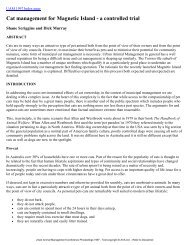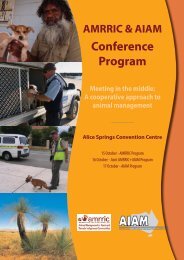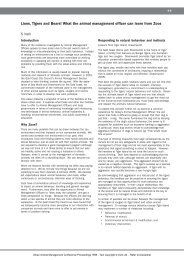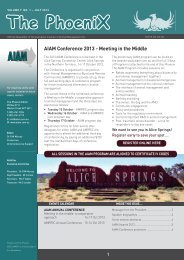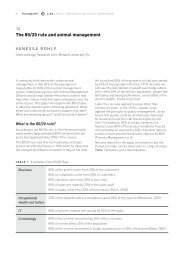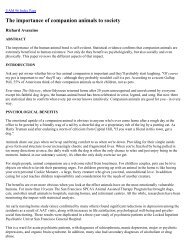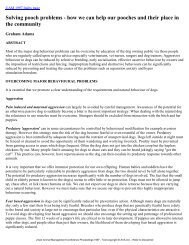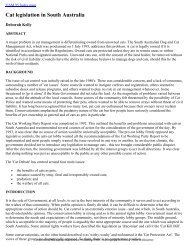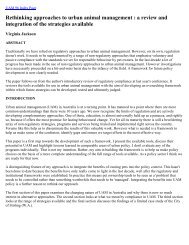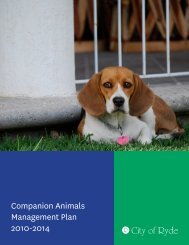Proceedings OF ThE - Australian Institute of Animal Management Inc
Proceedings OF ThE - Australian Institute of Animal Management Inc
Proceedings OF ThE - Australian Institute of Animal Management Inc
Create successful ePaper yourself
Turn your PDF publications into a flip-book with our unique Google optimized e-Paper software.
Annual Conference on <strong>Animal</strong> <strong>Management</strong> AIAM <strong>Proceedings</strong> 2012 97<br />
make dogs less aggressive and less likely to attack.<br />
This is an example <strong>of</strong> making the environment less<br />
risky, rather than relying on the behavioural change<br />
<strong>of</strong> all the individuals potentially in contact with<br />
dogs, through education or training (Haddon 1980).<br />
Modifying the environment rather than modifying<br />
the people is a well established principle in injury<br />
control, and there are many historical examples <strong>of</strong><br />
successful risk reduction employing this principle.<br />
Requiring swimming pools to be adequately fenced<br />
is an example <strong>of</strong> a successful environmental control<br />
strategy for drowning prevention, rather than relying<br />
on continuous supervision <strong>of</strong> children around pools.<br />
This alternative approach is particularly important<br />
with dog-attack control as there is no good evidence<br />
that education only approaches have reduced the<br />
risk <strong>of</strong> dog attack (Duperrex et al 2009).<br />
In summary, both the epidemiology literature and<br />
animal behaviour studies indicate that dog attacks<br />
are less likely among neutered dogs, and there is a<br />
suggestion that desexing dogs will reduce the most<br />
severe attacks on humans. Borrowing from what<br />
has been consistently proven to be the case in injury<br />
control, interventions that modify the environmental<br />
risk factors are more likely to be successful. In<br />
dog management, interventions that encourage the<br />
desexing <strong>of</strong> dogs are likely to directly reduce the risk<br />
<strong>of</strong> dog attacks.<br />
References<br />
Duperrex, O., Blackhall, K., Burri, M., & Jeannot, E. (2009).<br />
Education <strong>of</strong> children and adolescents for the prevention <strong>of</strong> dog<br />
ite injuries (review). Cochrane Database <strong>of</strong> Systematic Reviews,<br />
Issue 2. Art. No.: CD004726. DOI: 10.1002/14651858.CD004726.pub2.<br />
Gershman, K., Sacks, J., & Wright, J. (1994). Which dogs bite? A<br />
case-control study <strong>of</strong> risk factors. Pediatrics, 93(6): 913-917.<br />
Guy, N., Luescher, U., Dohoo, S., Spangler, E., Miller, J., Dohoo,<br />
I., & Bate, L. (2001). A case series <strong>of</strong> biting dogs: characteristics<br />
<strong>of</strong> the dogs, their behaviour, and their victims. Applied <strong>Animal</strong><br />
Behaviour Science, 74: 43-57.<br />
Haddon, W. (1980). Advances in the epidemiology <strong>of</strong> injuries as a<br />
basis for public policy. Public Health Reports, 95(5): 411-421.<br />
Messam, L., Kass, P., Chomel, B., & Hart, L. (2008). The human–<br />
canine environment: A risk factor for non-play bites? The<br />
Veterinary Journal, 177: 205-215.<br />
Overall, K., & Love, M. (2001). Dog bites to humans – demography,<br />
epidemiology, injury, and risk. Journal <strong>of</strong> the American Veterinary<br />
Medical Association, 218: 1923-1933.<br />
Reichler, I. (2009). Gonadectomy in cats and dogs: a review <strong>of</strong><br />
risks and benefits. Reproduction in Domestic <strong>Animal</strong>s, 44(Suppl.<br />
2): 29-35.<br />
Sacks, J., Lockwood, R., Hornreich, J., & Sattin, R. (1996). Fatal<br />
dog attacks, 1989-1994. Pediatrics, 97(6): 891-895.<br />
Shuler, C., DeBess, E., Lapidus, J., & Hedberg, K. (2008). Canine<br />
and human factors related to dog bite injuries. Journal <strong>of</strong> the<br />
American Veterinary Medical Association, 22: 542-546.<br />
Wright, J. (1985). Severe attacks by dogs: characteristics <strong>of</strong> the<br />
dogs, the victims, and the attack settings. Public Health Reports,<br />
100(1), 55-61.<br />
About the author<br />
Contact<br />
Dr Katina D’Onise<br />
MBBS MPH PhD FAFPHM<br />
Public Health Physician,<br />
Epidemiology Branch, South <strong>Australian</strong><br />
Department for Health and Ageing<br />
Email: katina.d’onise@health.sa.gov.au<br />
. . . . . . . . . . . . . . . . . . . . . . . . . . . . . . .<br />
. . . . . . . . . . . . . . . . . . . . . . . . . . . . . . .<br />
. . . . . . . . . . . . . . . . . . . . . . . . . . . . . . .<br />
. . . . . . . . . . . . . . . . . . . . . . . . . . . . . . .<br />
. . . . . . . . . . . . . . . . . . . . . . . . . . . . . . .<br />
. . . . . . . . . . . . . . . . . . . . . . . . . . . . . . .<br />
. . . . . . . . . . . . . . . . . . . . . . . . . . . . . . .<br />
. . . . . . . . . . . . . . . . . . . . . . . . . . . . . . .<br />
. . . . . . . . . . . . . . . . . . . . . . . . . . . . . . .<br />
. . . . . . . . . . . . . . . . . . . . . . . . . . . . . . .<br />
. . . . . . . . . . . . . . . . . . . . . . . . . . . . . . .<br />
. . . . . . . . . . . . . . . . . . . . . . . . . . . . . . .<br />
. . . . . . . . . . . . . . . . . . . . . . . . . . . . . . .<br />
. . . . . . . . . . . . . . . . . . . . . . . . . . . . . . .<br />
. . . . . . . . . . . . . . . . . . . . . . . . . . . . . . .<br />
. . . . . . . . . . . . . . . . . . . . . . . . . . . . . . .<br />
. . . . . . . . . . . . . . . . . . . . . . . . . . . . . . .<br />
. . . . . . . . . . . . . . . . . . . . . . . . . . . . . . .<br />
. . . . . . . . . . . . . . . . . . . . . . . . . . . . . . .<br />
. . . . . . . . . . . . . . . . . . . . . . . . . . . . . . .



